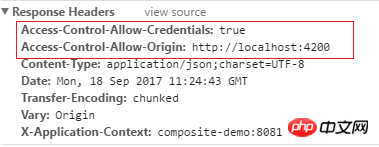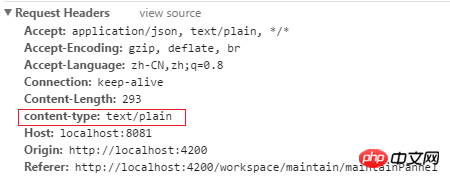
This article mainly introduces to you the solution to the cross-domain problem of Angular client requesting Rest service. It has certain reference value. Interested friends can refer to it. I hope it can help everyone.
1. Problem description: The origin is http://localhost:4200 and the service of http://localhost:8081 is requested. The console reports the following error, but the response is 200. The client and server IPs are the same, but the ports are different, so there is a cross-domain problem.
Copy codeThe code is as follows:
XMLHttpRequest cannot load No 'Access-Control-Allow-Origin' header is present on the requested resource. Origin ' http://localhost:4200' is therefore not allowed access.
2. Solution: Add @CrossOrigin annotation to the Restful method of server/api/v1/staffs, for example:
@CrossOrigin(origins = "*", maxAge = 3600) @RequestMapping(value = "/api/v1/staffs", produces = { "application/json" }, method = RequestMethod.GET) RestResponseList queryStaffs(@RequestParam(value = "limit", required = false, defaultValue = "20") int limit, @RequestParam(value = "offset", required = false, defaultValue = "0") int offset);
3. Resend the request to http://localhost:8081/api/v1/..., the request is successful. And the response header adds Access-Control-Allow-Credentials and Access-Control-Allow-Origin parameters. The @CrossOrigin annotation adds these two parameters to the response header to solve cross-domain problems.

#4. Also use the annotation @CrossOrigin in the server-side POST method to solve cross-domain problems.
@CrossOrigin(origins = "*", maxAge = 3600) @RequestMapping(value = "/api/v1/staffs", produces = { "application/json" }, method = RequestMethod.POST) RestResponse createStaff(@RequestBody RestRequest request);
The error is reported as follows:

5. Check the response code 415, the error reason:
"status": 415,
"error": "Unsupported Media Type",
"exception": "org.springframework.web.HttpMediaTypeNotSupportedException",
"message": "Content type 'text/plain ;charset=UTF-8' not supported"
6. Further check the request header information, the content-type is text/plain. It does not match the Content-Type:application/json;charset=UTF-8 type of Response Headers, so an error is reported.

#7. Specify the request header content-type as application/json, such as adding Headers in Angular. Send a Post request and the request is successful.
let headers = new Headers({ 'Content-Type': 'application/json' }); let options = new RequestOptions({ headers }); return this.http.post(this.staffCreateURL, body, options).map((response: Response) => { //return this.http.get(this.userLoginURL).map((response:Response)=> { let responseInfo = response.json(); console.log("====请求staffCreateURL成功并返回数据start==="); console.log(responseInfo); console.log("====请求staffCreateURL成功并返回数据end==="); let staffName = responseInfo.responseInfo.staffName; console.log(staffName); return responseInfo; })
Another: You can also add response header parameters to the HttpServletResponse object through the setHeader("Access-Control-Allow-Origin", "*") method to solve cross-domain problems. , which is the @CrossOrigin annotation method. It is recommended to use annotations for convenience.
Related recommendations:
Understand JavaScript, Rest parameters in functions
The above is the detailed content of How to solve the cross-domain problem of Angular client requesting Rest service. For more information, please follow other related articles on the PHP Chinese website!
 The difference between ++a and a++ in c language
The difference between ++a and a++ in c language How to solve 400 bad request
How to solve 400 bad request The difference between bond0 and bond1
The difference between bond0 and bond1 How to solve problems when parsing packages
How to solve problems when parsing packages How to open python after it is installed
How to open python after it is installed The difference between external screen and internal screen broken
The difference between external screen and internal screen broken How to type the inscription on the coin circle?
How to type the inscription on the coin circle? Complete list of CSS color codes
Complete list of CSS color codes



